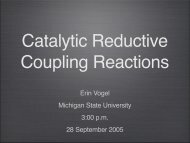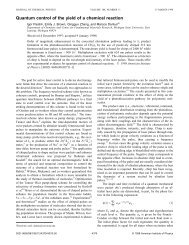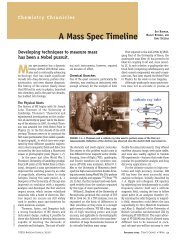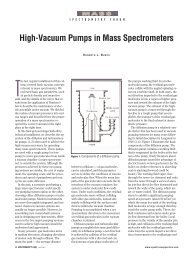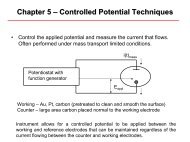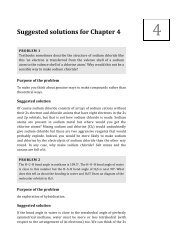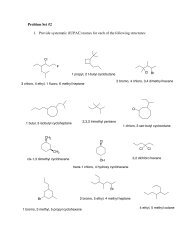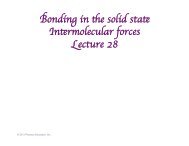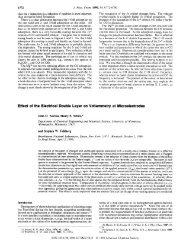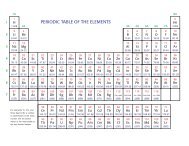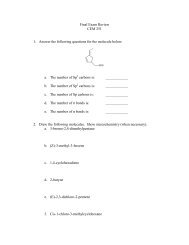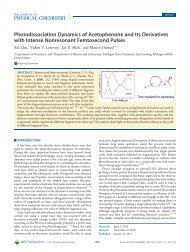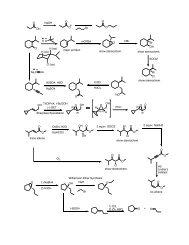Catalytic Asymmetric Chlorination & Bromination
Catalytic Asymmetric Chlorination & Bromination
Catalytic Asymmetric Chlorination & Bromination
Create successful ePaper yourself
Turn your PDF publications into a flip-book with our unique Google optimized e-Paper software.
Strategies for <strong>Catalytic</strong> <strong>Asymmetric</strong> Electrophilic<br />
a Halogenation of Carbonyl Compounds<br />
R 1<br />
R 2<br />
O<br />
Y<br />
Catalyst<br />
[X + ]<br />
Hintermann, L. ; Togni, A. Angew. Chem. Int. Ed. 2000, 39, 4359 – 4362<br />
Hamashima, Y.; Sodeoka, M. et al J. Am. Chem. Soc. 2002, 124, 14530 –14531<br />
France, S.; Lectka, T. et al J. Am. Chem. Soc. 2004, 126, 4245 – 4255<br />
Brochu, M. P.; Brown, S. P. ; MacMillan, D. W. C. J. Am. Chem. Soc. 2004, 126, 4108 – 4109<br />
Halland, N. ; Jørgensen, K. A. et al J. Am.Chem. Soc. 2004, 126, 4790 – 4791<br />
Marigo, M. ; Jørgensen, K. A. et al Angew. Chem. Int. Ed. 2004, 43, 5507 – 5510<br />
Zhang, Y. ; Shibatomi, K.; Yamamoto, H. J. Am. Chem. Soc. 2004, 126, 15038 –15039<br />
Marigo, M. ; Jørgensen, K. A. et al Angew. Chem. Int. Ed. 2005, 44, 2 – 5 (early view)<br />
Ali Z. Ding<br />
Advisor: Prof. W. D. Wulff<br />
May 12 2005<br />
R 1<br />
X<br />
!<br />
R 2<br />
O<br />
Y
Introduction<br />
a-Halogenated Carbonyl Compounds<br />
Linchpins for further stereospecific manipulations<br />
Halogen substituents can sometimes dramatically alter its physical, chemical<br />
and biological properties<br />
Increasingly important structural motifs in medicinal chemistry and material<br />
sciences.<br />
F 3C<br />
MeO<br />
F<br />
Currently being assessed worldwide in phase III clinical trials<br />
for treatment of acute ischemic stoke<br />
Oestreich, M. Angew. Chem. Int. Ed., 2005, 44, 2324-2327<br />
Ibrahim, H.; Togni, A. Chem. Commun. 2004, 1147 – 1155<br />
N<br />
H<br />
O<br />
BMS-204352<br />
MaxiPost<br />
Cl
Introduction<br />
Approaches to the Chiral a-Halogenated Carbonyl Compounds<br />
(1) Reagent-controlled halogenation: asymmetric halogenation of enolates using chiral<br />
electrophilic halogenating agents<br />
R 1<br />
(2) Substrate-controlled halogenation: diastereoselective electrophilic halogenation of<br />
chiral enolates or enol ethers<br />
R 1<br />
(3) <strong>Catalytic</strong> asymmetric halogenation of carbonyl compounds<br />
R 1<br />
R 2<br />
R 2<br />
O<br />
R 2<br />
O<br />
O<br />
Y<br />
Y*<br />
Y<br />
!<br />
R<br />
[X + ]<br />
[X + ]<br />
Catalyst<br />
[X + ]<br />
Oestreich, M. Angew. Chem. Int. Ed., 2005, 44, 2324-2327<br />
Taylor, S. D.; Kotoris, C. C. and Hum, G. Tetrahedron, 1999, 55,12431-12477<br />
R 1<br />
R 1<br />
R 1<br />
X<br />
X<br />
!<br />
R 2<br />
!<br />
R 2<br />
X<br />
O<br />
!<br />
R 2<br />
O<br />
O<br />
Y<br />
Y*<br />
Y
Noncatalytic Halogenation<br />
Substrate-controlled Halogenation: Use of Chiral Auxiliaries<br />
Oestreich, M. Angew. Chem. Int. Ed., 2005, 44, 2324-2327<br />
Taylor, S. D.; Kotoris, C. C. and Hum, G. Tetrahedron, 1999, 55,12431-12477
Noncatalytic Halogenation<br />
Reagent-controlled Halogenation: Chiral Fluorinating Reagents<br />
Pioneering work: Differding, E. and Lang, R. W. Tetrahehron Lett. 1988, 29, 6087-6090<br />
• Moderate yields and low to moderate enantioselectivities<br />
• Syntheses of these reagents require several steps<br />
Wong, C.-H., Angew. Chem. Int. Ed., 2005, 44, 192<br />
Taylor, S. D.; Kotoris, C. C. and Hum, G. Tetrahedron, 1999, 55,12431-12477
Noncatalytic Halogenation<br />
Reagent-controlled Halogenation: Cinchona Alkaloids Fluorinating Reagents<br />
N<br />
OH<br />
[F + ]<br />
N<br />
F<br />
X -<br />
OH<br />
[F + ] =<br />
Cl<br />
PhSO2 N<br />
2BF - N F<br />
4<br />
N<br />
F<br />
PhSO2 N<br />
N<br />
Selectfluor,<br />
or F-TEDA<br />
N-fluorobenzenesulfonimide<br />
or NFSI<br />
10 11 12 13<br />
Cinchona alkaloids (CA) are readily available in both pseudo-enantiomeric forms<br />
Easily prepare, more reactive<br />
Can be generated and used in situ<br />
Can be “reloaded” by F-TEDA or NFSI and reused without loss in selectivity<br />
Can such CA be used catalytically in these reactions?<br />
Ibrahim, H.; Togni, A. Chem. Commun. 2004, 1147 – 1155
<strong>Catalytic</strong> <strong>Asymmetric</strong> Fluorination<br />
Organo-<strong>Catalytic</strong> Enantioselective Fluorination by Phase-Transfer Catalysts<br />
Kim, D. Y. and Park, E. J. Org. Lett., 2002, 4, 545–547.
<strong>Catalytic</strong> <strong>Asymmetric</strong> Fluorination<br />
Organo-<strong>Catalytic</strong> Enantioselective Fluorination by L-Proline Derevatives<br />
R<br />
O<br />
Challenges:<br />
H<br />
+ F + Source<br />
• N-fluorination of catatlyst<br />
• Fluorination of substrate should be faster<br />
• Racemization and difluorination<br />
• Both SM and product can form enamine species<br />
• a-proton of product is more acidic<br />
• F atom is not big enough to contribute to an added steric shielding<br />
• Products are not stable to survive silica gel<br />
N<br />
H<br />
F !<br />
• Screen catalysts and solvents<br />
• Lower the catalyst loading<br />
• Screen fluorinating reagents<br />
Marigo, M. ; Jørgensen, K. A. et al Angew. Chem. Int. Ed. 2005, 44, 2 – 5<br />
R*<br />
R<br />
O<br />
H<br />
NaBH 4 F !<br />
R<br />
OH
<strong>Catalytic</strong> <strong>Asymmetric</strong> Fluorination<br />
Organo-<strong>Catalytic</strong> Enantioselective Fluorination by L-Proline Derevatives<br />
O<br />
N<br />
H X<br />
14a, X= OH<br />
14b, X= NH2 R<br />
O<br />
H<br />
Ph<br />
N<br />
H<br />
Ph<br />
15 16,<br />
NFSI, 16(1mol%)<br />
MTBE, RT<br />
• In the solvents other than MTBE, catalyst 16 decomposes<br />
• Products were reduced to alcohol in situ<br />
Dr. MacMillan’s Work:<br />
OTMS<br />
N Ar<br />
H Ar<br />
Enantioselective Organocatalytic Direct a-Fluorination:<br />
F<br />
R<br />
Beeson, T. D. and MacMillan, D. W. C. J. Am. Chem. Soc. 2005, 127, in press<br />
True nucleophiles toward electrophilic fluorine: enols, enolates or enamines<br />
CF 3<br />
CF 3<br />
Marigo, M. ; Jørgensen, K. A. et al Angew. Chem. Int. Ed. 2005, 44, 2 – 5<br />
O<br />
H<br />
Ar=<br />
NaBH 4<br />
MeOH, RT<br />
R= Pr (96%ee), Bu(91%ee), Hex (96%ee), BnO(CH 2) 3(91%ee),<br />
Bn (93%ee), Cy (96%ee), tBu(97%ee), 1-Ad (96%ee)<br />
F<br />
!<br />
R<br />
OH<br />
MTBE=<br />
Yield: 55-95%<br />
O<br />
PhSO2 N<br />
PhSO2 NFSI<br />
F
<strong>Catalytic</strong> <strong>Asymmetric</strong> Fluorination<br />
Chiral Lewis Acid Catalyzed <strong>Asymmetric</strong> Fluorination<br />
• Addition of sub-stoichiometric amount of Lewis acid significantly<br />
accelerates formation of fluorination product<br />
12 17 18<br />
Ti-based Lewis acids are the most potent catalysts<br />
Umemoto, T et al J. Am. Chem. Soc., 1990, 112, 8563–8575<br />
Hintermann, L. ; Togni, A. Angew. Chem. Int. Ed. 2000, 39, 4359 – 4362
<strong>Catalytic</strong> <strong>Asymmetric</strong> Fluorination<br />
TiCl 2 [R,R-(TADDOLLato)] Catalyzed <strong>Asymmetric</strong> Fluorination<br />
12<br />
Hintermann, L. ; Togni, A. Angew. Chem. Int. Ed. 2000, 39, 4359 – 4362<br />
Ibrahim, H.; Togni, A. Chem. Commun. 2004, 1147 – 1155
<strong>Catalytic</strong> <strong>Asymmetric</strong> Fluorination<br />
Mechanism of Ti Catalyzed <strong>Asymmetric</strong> Fluorination<br />
Piana, S.; Togni, A. et al Angew. Chem., Int. Ed., 2002, 41, 979–982<br />
Ibrahim, H.; Togni, A. Chem. Commun. 2004, 1147 – 1155<br />
12<br />
The bidentate nature of substrates is beneficial for high facial selectivity
<strong>Catalytic</strong> <strong>Asymmetric</strong> Fluorination<br />
<strong>Asymmetric</strong> Fluorination Catalyzed by Other Lewis Acids<br />
13<br />
Alcoholic solvents can work well<br />
Not sensitive to water<br />
Catalyst can be recycled and re-used without loss of any slectivity<br />
Hamashima, Y.; Sodeoka, M. et al J. Am. Chem. Soc., 2002, 124, 14530–14531.
<strong>Catalytic</strong> <strong>Asymmetric</strong> Fluorination<br />
O<br />
N N<br />
Ph<br />
M<br />
Ph<br />
<strong>Asymmetric</strong> Fluorination Catalyzed by Other Lewis Acids<br />
O<br />
62 M= Cu, X - = OTf<br />
63 M= Ni, X - = ClO 4<br />
X -<br />
13<br />
Ibrahim, H.; Togni, A. Chem. Commun. 2004, 1147 – 1155<br />
Ma, J.-A. and Cahard, D. Tetrahedron: Asymmetry, 2004, 15, 1007<br />
HFIP=<br />
F 3C CF 3<br />
Shibata, N.; Ishimaru, T.; Nagai, T., Kohno, J. and T. Toru Synlett 2004, 1703 –1706<br />
OH
<strong>Catalytic</strong> <strong>Asymmetric</strong> <strong>Chlorination</strong> & <strong>Bromination</strong><br />
R 1<br />
O O<br />
Me<br />
Chiral Lewis Acid Catalyzed <strong>Asymmetric</strong> <strong>Chlorination</strong> & <strong>Bromination</strong><br />
OR 2<br />
Me OBn<br />
Me<br />
R 1<br />
O O<br />
O<br />
+ N<br />
O<br />
Cl<br />
+<br />
I Cl<br />
64 65<br />
O O<br />
R 2<br />
R 3<br />
O<br />
+ N<br />
O<br />
X<br />
X<br />
5mol%<br />
38 or 39<br />
MeCN, rt<br />
5mol% 38<br />
1.2eq py<br />
toluene, 50 o C<br />
10mol% 67<br />
R 1<br />
O O<br />
X Me<br />
O O<br />
OR 2<br />
Hintermann, L. and Togni, A. Helv, Chim. Acta, 2000, 83, 2425–2435<br />
X= Cl, up to 88%ee<br />
X= Br, up to 23%ee<br />
Me OBn<br />
Cl Me<br />
(S)-66, 67%, 71%ee<br />
With Cl2, (S)-66, 62%, 30%ee<br />
Hintermann, L. and Togni, A. Helv, Chim. Acta, 2004, 87, 605–610<br />
Et 2O<br />
R 1<br />
O O<br />
R 2 X<br />
OR 2<br />
X= Cl, up to 77%ee<br />
X= Br, up to 82%ee<br />
Marigo, M.; Kumaragurubaran, N.; Jørgensen, K. A. Chem. Eur. J. 2004,10, 2133 – 2137<br />
Oestreich, M. Angew. Chem. Int. Ed., 2005, 44, 2324-2327<br />
O<br />
O<br />
N N<br />
t-Bu<br />
Cu<br />
(S, S)-67<br />
t-Bu<br />
2 OTf -
<strong>Catalytic</strong> <strong>Asymmetric</strong> <strong>Chlorination</strong> & <strong>Bromination</strong><br />
Cl<br />
O<br />
67<br />
R<br />
Organo-Catalyzed <strong>Asymmetric</strong> <strong>Chlorination</strong> & <strong>Bromination</strong> Acyl Halides<br />
Tadem halogenation/esterification process of acyl halides<br />
Cl<br />
Cl<br />
MeO<br />
Cl<br />
Cl<br />
Base<br />
THF<br />
-78oC Cl<br />
Cl<br />
O<br />
N<br />
69<br />
N<br />
O<br />
Br<br />
Br<br />
C<br />
R<br />
68 (2.0eq)<br />
O Ph<br />
O<br />
Br<br />
70 71<br />
Br<br />
O<br />
69(10mol%)<br />
70 or 71 (1.0eq)<br />
THF, -78 o C<br />
Nu<br />
LG X<br />
ArO<br />
O<br />
R<br />
X 72<br />
+ Nu<br />
O<br />
74<br />
LG -<br />
X<br />
LG<br />
R<br />
O<br />
LG -<br />
X<br />
R<br />
72<br />
Nu<br />
69<br />
LG X<br />
+ Nu<br />
70 or 71<br />
The choice of chlorinating agents is pivotal for the reaction to turn over<br />
France, S.; Lectka, T. et al J. Am. Chem. Soc. 2004, 126, 4245 – 4255<br />
O<br />
O -<br />
C<br />
68<br />
R<br />
R<br />
73<br />
Base<br />
Cl<br />
O<br />
67<br />
R
Organo-<strong>Catalytic</strong> <strong>Asymmetric</strong> <strong>Chlorination</strong> & <strong>Bromination</strong><br />
Optimization of Reaction Conditions<br />
The choice of chlorinating agents: the window is very narrow<br />
The choice of base: reactive, cheap, easy to handle<br />
Me 2N NMe 2<br />
R<br />
O<br />
X<br />
N O<br />
O Cl<br />
Unreactive: Too reactive: ,<br />
Me 2N NMe 2<br />
67 68<br />
70<br />
C6Cl5O H<br />
Me2N NMe2 69<br />
70 71<br />
O<br />
C<br />
R<br />
75<br />
76<br />
Cl 5C 6O<br />
France, S.; Lectka, T. et al J. Am. Chem. Soc. 2004, 126, 4245 – 4255<br />
Cl 2<br />
O<br />
R
Organo-<strong>Catalytic</strong> <strong>Asymmetric</strong> <strong>Chlorination</strong> & <strong>Bromination</strong><br />
Choice of Base and Summary<br />
O<br />
Cl<br />
67<br />
R<br />
NaH, 15-crown-5<br />
69(10mol%), 70(1.0eq)<br />
THF, -78oC to rt, 4h<br />
O<br />
R<br />
Cl5C6O Cl<br />
75<br />
R= Ph, PhOCH2, 1-Np, p-NO2Ph, Et, o-ClPh Yield: 43-79%, ee: 90-99%<br />
Cl<br />
O<br />
67<br />
R<br />
NaHCO3, 15-crown-5<br />
69(10mol%), 70(1.0eq)<br />
ClPh, -35oC to rt, 5h<br />
R= Ph, PhOCH2, 1-Np, p-MeOPh<br />
Moderate yields, high enantioselectivity<br />
Inexpensive reagents<br />
Can be scaled up<br />
O<br />
R<br />
Cl5C6O Cl<br />
75<br />
Yield: 56-68%, ee: 88-91%<br />
Ketenes from other sources (Wolff rearrangement) can be used as well<br />
France, S.; Lectka, T. et al J. Am. Chem. Soc. 2004, 126, 4245 – 4255
Organo-<strong>Catalytic</strong> <strong>Asymmetric</strong> <strong>Chlorination</strong><br />
<strong>Asymmetric</strong> <strong>Chlorination</strong> of Aldehydes Catalyzed by Chiral Amines<br />
76 77<br />
78<br />
70<br />
8 examples<br />
Yield: 60-88%<br />
ee: 97-99%<br />
Such cyclic transition state might enforce activation of 70 in the asymmetric environment<br />
of an e-rich enamine mediated by proton<br />
Brochu, M. P.; Brown, S. P. ; MacMillan, D. W. C. J. Am. Chem. Soc. 2004, 126, 4108 – 4109<br />
70<br />
79<br />
80
Organo-<strong>Catalytic</strong> <strong>Asymmetric</strong> <strong>Chlorination</strong> of Aldehydes<br />
<strong>Asymmetric</strong> <strong>Chlorination</strong> of Aldehydes: Catalysts and Chlorinating Reagents<br />
82<br />
83<br />
82<br />
83<br />
70<br />
70<br />
70<br />
70<br />
81 82 83<br />
L-Proline doesn’t work well<br />
NCS doesn’t work well<br />
Brochu, M. P.; Brown, S. P. ; MacMillan, D. W. C. J. Am. Chem. Soc. 2004, 126, 4108 – 4109<br />
Cl<br />
Cl<br />
Cl<br />
N<br />
O O<br />
NCS<br />
Cl<br />
Cl<br />
70<br />
Cl<br />
Cl<br />
O
Organo-<strong>Catalytic</strong> <strong>Asymmetric</strong> <strong>Chlorination</strong> of Aldehydes<br />
<strong>Asymmetric</strong> <strong>Chlorination</strong> of Aldehydes: the Solvent Effects<br />
Inert to halogenation reagent<br />
Optimal selectivity, reaction rate, and chemical yield<br />
82<br />
Product epimerization, formation of R,R-dichlorooctanal, or octanal aldol<br />
dimerization were comprehensively suppressed using these conditions<br />
Brochu, M. P.; Brown, S. P. ; MacMillan, D. W. C. J. Am. Chem. Soc. 2004, 126, 4108 – 4109<br />
82
Organo-<strong>Catalytic</strong> <strong>Asymmetric</strong> <strong>Chlorination</strong> of Aldehydes<br />
<strong>Asymmetric</strong> <strong>Chlorination</strong> of Aldehydes: The Scope<br />
Brochu, M. P.; Brown, S. P. ; MacMillan, D. W. C. J. Am. Chem. Soc. 2004, 126, 4108 – 4109
Organo-<strong>Catalytic</strong> <strong>Asymmetric</strong> <strong>Chlorination</strong> of Aldehydes<br />
70<br />
<strong>Asymmetric</strong> <strong>Chlorination</strong> of Aldehydes: b-Chiral Aldehydes<br />
Internal asymmetric induction is almost completely over-compensated<br />
Selectivity is sterically and chemically good<br />
Substrate scope is broad<br />
All the reagents (70, 82 and - 82) are bench stable and commercially available<br />
Products are stable<br />
- 82<br />
82<br />
Brochu, M. P.; Brown, S. P. ; MacMillan, D. W. C. J. Am. Chem. Soc. 2004, 126, 4108 – 4109
Organo-<strong>Catalytic</strong> <strong>Asymmetric</strong> <strong>Chlorination</strong> of Aldehydes<br />
<strong>Asymmetric</strong> <strong>Chlorination</strong> of Aldehydes: Jørgensen’s Work<br />
H<br />
O<br />
iPr<br />
Catalyst<br />
NCS<br />
Halland, N. ; Jørgensen, K. A. et al J. Am.Chem. Soc. 2004, 126, 4790 – 4791<br />
H<br />
O<br />
!<br />
Cl<br />
iPr<br />
Ph<br />
Cl<br />
N<br />
O O<br />
NCS<br />
O<br />
N<br />
H NH2 3c<br />
N<br />
H<br />
3i<br />
Ph
Organo-<strong>Catalytic</strong> <strong>Asymmetric</strong> <strong>Chlorination</strong> of Aldehydes<br />
<strong>Asymmetric</strong> <strong>Chlorination</strong> of Aldehydes: The Scope<br />
H<br />
O<br />
NCS (1.3eq) O<br />
1<br />
R<br />
3c or 3i (10mol%)<br />
CH2Cl2, rt, 1-10h<br />
H<br />
! R<br />
Cl<br />
2<br />
<strong>Asymmetric</strong> <strong>Bromination</strong> & Iodination of Aldehydes<br />
H<br />
H<br />
O<br />
O<br />
1d<br />
1a<br />
NBS<br />
3i (10mol%)<br />
CH 2Cl 2, rt<br />
NIS<br />
3i (10mol%)<br />
CH 2Cl 2, rt<br />
Halland, N. ; Jørgensen, K. A. et al J. Am.Chem. Soc. 2004, 126, 4790 – 4791<br />
H<br />
H<br />
O<br />
O<br />
!<br />
I<br />
!<br />
Br<br />
80%ee<br />
24%ee<br />
Ph<br />
Cl<br />
N<br />
O O<br />
NCS<br />
O<br />
N<br />
H NH2 3c<br />
N<br />
H<br />
3i<br />
Ph
Organo-<strong>Catalytic</strong> <strong>Asymmetric</strong> <strong>Chlorination</strong> of Ketones<br />
Organo-Catalyzed <strong>Asymmetric</strong> <strong>Chlorination</strong> of Ketones<br />
Marigo, M. ; Jørgensen, K. A. et al Angew. Chem. Int. Ed. 2004, 43, 5507 – 5510<br />
Cl<br />
N<br />
O O<br />
NCS
Organo-<strong>Catalytic</strong> <strong>Asymmetric</strong> <strong>Chlorination</strong> of Ketones<br />
<strong>Asymmetric</strong> <strong>Chlorination</strong> of Ketones: Effects of Additives & Solvent<br />
CH 3 CN is the best solvent<br />
Significant improvement by adding acids:<br />
• Promotion of enamine formation<br />
• Suppression of catalyst chlorination<br />
Marigo, M. ; Jørgensen, K. A. et al Angew. Chem. Int. Ed. 2004, 43, 5507 – 5510<br />
Ph<br />
Ph<br />
Cl<br />
N<br />
O O<br />
NCS<br />
H<br />
N<br />
N<br />
H<br />
3i
Organo-<strong>Catalytic</strong> <strong>Asymmetric</strong> <strong>Chlorination</strong> of Ketones<br />
R<br />
O<br />
1<br />
R<br />
<strong>Asymmetric</strong> <strong>Chlorination</strong> of Ketones: The Scope<br />
3i (20mol%)<br />
2-NO 2-PhCO 2H (50mol%)<br />
NCS (2eq), MeCN, 20h<br />
R<br />
O<br />
2<br />
!<br />
Cl<br />
R<br />
Ph<br />
Ph<br />
High e.e.<br />
H<br />
N<br />
N<br />
H<br />
3i<br />
Moderate yields: poly-chlorination occurs<br />
Broad substrate scope<br />
Marigo, M. ; Jørgensen, K. A. et al Angew. Chem. Int. Ed. 2004, 43, 5507 – 5510<br />
Cl<br />
N<br />
O O<br />
NCS
<strong>Asymmetric</strong> <strong>Chlorination</strong> of Ketones<br />
Back to Reagent Controlled <strong>Asymmetric</strong> <strong>Chlorination</strong> of Ketones<br />
Reagent-controlled process can sometimes be competitive alternative!<br />
R 1<br />
OSi<br />
R 2<br />
R 3<br />
+<br />
X<br />
O<br />
X<br />
Cl Cl 1<br />
Zhang, Y. ; Shibatomi, K.; Yamamoto, H. J. Am. Chem. Soc. 2004, 126, 15038 –15039<br />
O<br />
Lewis acid<br />
X=R or OR R 1<br />
O<br />
!<br />
R 3<br />
Cl R 2<br />
Chirality of auxiliary (X) could be transferred to silicon enolates<br />
Lewis acids are necessary to activate 1<br />
Chlorinating reagents 1 can be prepared easily
<strong>Asymmetric</strong> <strong>Chlorination</strong> of Ketones<br />
<strong>Asymmetric</strong> <strong>Chlorination</strong> of Ketones: Effects of X group & Si Group<br />
ZrCl 4 is uniquely reactive<br />
The size of X group<br />
The size of si group<br />
Yields are high (>90%)<br />
Zhang, Y. ; Shibatomi, K.; Yamamoto, H. J. Am. Chem. Soc. 2004, 126, 15038 –15039
<strong>Asymmetric</strong> <strong>Chlorination</strong> of Ketones<br />
<strong>Asymmetric</strong> <strong>Chlorination</strong> of Ketones: Scope
<strong>Asymmetric</strong> <strong>Chlorination</strong> of Ketones<br />
<strong>Asymmetric</strong> <strong>Chlorination</strong> of Ketones: Potential to be <strong>Catalytic</strong><br />
O<br />
O<br />
OSi<br />
( ) n<br />
O O<br />
1-Np Cl Cl 1-Np<br />
1c<br />
CF 3SO 2H<br />
ZrCl 4<br />
O<br />
( ) n<br />
O<br />
Cl<br />
O<br />
O O<br />
1-Np H Cl<br />
2c<br />
1-Np<br />
CF 3SO 2Cl<br />
2c can be easily recovered and chlorinated back to 1c<br />
Recovered 1c can be re-used for the reaction<br />
This novel process might be extended to catalytic asymmetric variants!<br />
Zhang, Y. ; Shibatomi, K.; Yamamoto, H. J. Am. Chem. Soc. 2004, 126, 15038 –15039
<strong>Catalytic</strong> <strong>Asymmetric</strong> Halogenation of Carbonyl Compounds<br />
Conclusions<br />
• Enantioselective electrophilic a-halogenation of carbonyl compounds: a topical<br />
area of current asymmetric catalysis<br />
• A new tool has presented itself to synthetic organic chemistry<br />
• More applications are expected
Dr. Togni<br />
ETH<br />
Dr. MacMillan<br />
Caltech<br />
Cl<br />
Cl<br />
Cl<br />
N<br />
N<br />
F<br />
O<br />
PhSO 2<br />
2BF -<br />
4 N F<br />
PhSO 2<br />
Selectfluor,<br />
or F-TEDA N-fluorobenzenesulfonimide<br />
or NFSI<br />
12 13<br />
Cl<br />
Cl<br />
Cl<br />
Br<br />
Br<br />
Br<br />
O<br />
X<br />
N O<br />
Cl<br />
To What They Should Thank?<br />
Br<br />
70 71<br />
Wong, C.-H., Angew. Chem. Int. Ed., 2005, 44, 192<br />
O<br />
Dr. Jørgensen<br />
Aarhus U.<br />
X= Cl, NCS<br />
X= Br, NBS<br />
X= I , NIS<br />
Taylor, S. D.; Kotoris, C. C. and Hum, G. Tetrahedron, 1999, 55,12431-12477<br />
Dr. Lectka<br />
Johns Hopkins U.<br />
Dr. Yamamoto<br />
U. of Chicago



